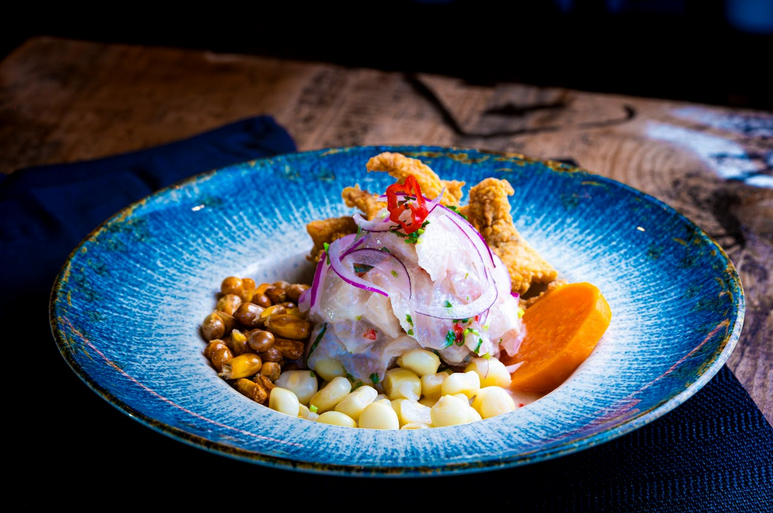Raw fish is one of the trickiest ingredients to prepare correctly. It often has a mild and delicate flavor that is difficult to highlight, and it is also not for everyone.
But if you love raw fish and want to explore other dishes outside of sushi, you can give ceviche a go, a staple dish in Latin cuisine. Today, we’ll explain this dish and show you how to make it.
What is Ceviche?
Ceviche is a seafood dish containing diced raw fish marinated in lemon or lime juice. This combination cures the fish protein, making it opaque, firm, and tasty—a process best described by the term “denaturing.” Denaturing usually happens when you cook with heat, which the cubed raw fish and citrus recreate for a delicious dish.
Once the fish is cured, colorful seasonings are added to it. Depending on the variety of ceviche you're making, you can use onions, cilantro, peppers, or other seasonings. Overall, ceviche showcases fresh fish and a rich taste.
Tracing Ceviche’s History: Where Did It Originate?
Because ceviche was made thousands of years ago, no recipes for its earliest varieties exist. However, it’s believed that ceviche was made in or near Huanchaco, a town on Peru’s northern Pacific coast.
Chef and food historian Maricel Presilla cited National Geographic as stating that fishermen could’ve eaten the fish they caught 3,000 years ago. For the marinade, the Moche people used South American chilies instead of the citrus now used in ceviche. This was eventually replaced with onions, citrus (bitter oranges), lemons, and limes, with Spanish and Portuguese traders bringing the last two fruits.
But for some historians, ceviche may have been marinated in the juice of the tumbo. It’s said that, after returning to shore, Peruvian fishermen soaked their catch in the slightly sour liquid. Presilla contradicted the claim by saying that raw fish could’ve been seasoned with seaweed and chili peppers.
How Was Ceviche Named?
Various theories about how ceviche was named have emerged. Some say the word came from the Andalusian Arabic, while others claim it originated from an Anglo-Saxon person’s reaction to eating the extremely spicy dish.
Another theory suggests that the word “ceviche” was derived from “cebo,” or the small pieces of fish used as bait or cooked into small meals. Others associate the name with the Quechua word “siwichi,” meaning fresh or tender fish.
Which Ingredients Are Commonly Used In Ceviche?
Now, you may wonder, “What are the ingredients for ceviche?” Manuel Atanasio Fuentes described the dish’s (presumably) original recipe in his book Lima, apuntes históricos, descriptivos, estadísticos y de costumbres. The dish contains bits of fish or shrimp mixed with sour orange juice and plenty of chili and salt. Making ceviche this way marinates the fish to absorb flavor.
Looking at this account, fish, citrus, and seasonings are the main ingredients for ceviche. But in some South American countries, cooks use different ingredients for ceviche made outside the continent. Read on to learn which ingredients make ceviche delicious.
Raw Fish
Ceviche isn’t complete without raw fish. If you plan to cook ceviche and want it fresh and delicious, buy fresh fish from a trusted fishmonger or seafood supplier. They’ll tell you what kind of fish is best for ceviche, although you should consider some things when choosing fresh fish. Remember: fresh fish smells briny and feels firm to the touch.
So, what fish is best for ceviche? Generally, you’d want white, firm, and flaky fish that absorbs flavors easily. You can make ceviche with any of these kinds of fish:
1) Snapper
2) Sea bass
3) Halibut
4) Mahi-mahi
5) Fluke
6) Flounder
7) Red snappers
8) Halibut
9) Sashimi-quality tuna
Other cooks use shrimp, scallops, squid, or octopus. If you’re substituting these kinds of seafood for raw fish, blanch them before making ceviche. Cook your chosen ingredient in boiling, salted water until it turns opaque, then soak it in ice water.
Toppings
Ceviche also contains toppings for extra texture and flavor.
For instance, Peruvian ceviche can be topped with corn, cooked sweet potato, and green herbs to complement its fresh flavor. Alternatively, mangoes, papayas, or pineapples can make ceviche a sweet treat, while habaneros and bell peppers give you a crunchy, spicy dish. Avocado can also be used for a creamy twist on ceviche, with the acid preventing browning.
Other toppings added to ceviche include popcorn and toasted corn kernels. Both make the dish a little crunchier without any sweetness or spiciness.
How to Make Peruvian Ceviche
To make Peruvian ceviche, try this recipe with salt, lime juice, and aji limo chili to taste.









